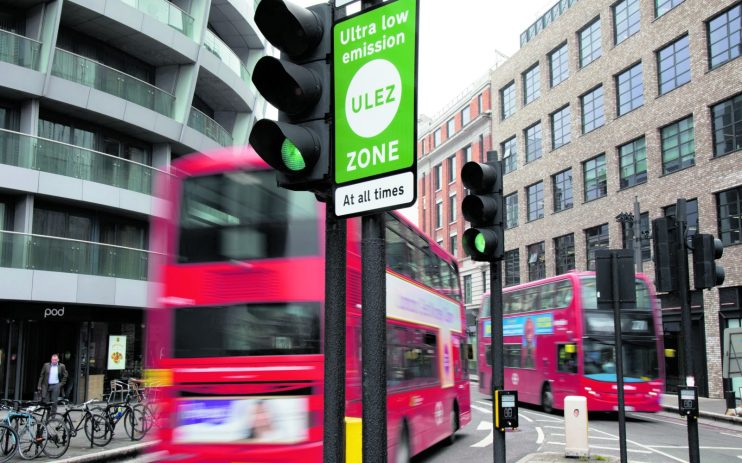Will the new ultra-low emission zone affect your house price?

The signs are up, the maps have been published – it’s ULEZ time. On Monday, the expanded ultra-low emission zone kicks in, casting a warm glow of low emissions not just over Westminster, but every surrounding neighbourhood within the often-smelly, usually-congested north circular. According to one logistics company, this long-planned expansion may mean that getting your shopping delivered costs more – but will the £12.50 daily charge to drive your non-ULEZ complaint vehicle have any effect on the property market?
The consensus from agents is a firm no. “Property prices are so high that it’s negligible,” says Edward Towers, director of prime central London advisory firm Aykroyd & Co. “I cannot say the ULEZ has been an issue for any of our buyers or sellers,” says James Hyman, head of residential at Cluttons. “It definitely hasn’t come as a shock – the mayor has been making it more difficult to drive or own a car in central London for years.” Nina Harrison, London specialist at buying agency Haringtons agrees that attitudes are changing: “A ULEZ tax country-wide feels inevitable – there is a general acceptance that we’ve got to improve our emissions. Those wanting to live in zones one and two in London know that it’s electric or public transport.”
Financially speaking, if there is to be a winner from the expanded ULEZ – apart from TfL, which could raise up to £2m a day from the new map – it is likely to be the owners of houses within the zone. “If I had a choice of two streets parallel to one another, one in the zone – which means that the cars driving past my front door are cleaner – and one not in the zone, I’d rather be in the former,” says Marc Schneiderman, director of London agents Arlington Residential. “The winners are likely to be the people who are living within a cleaner, greener environment that is less toxic.”
For these homeowners, higher values might come from a new division: whether or not you have environmentally future-proofed your home. “As clean air quality rises up the political agenda, it will come to have an impact on property too,” says independent buying agent Thea Carroll. “A few years down the line, I think people will be a lot more shrewd about acquiring properties that haven’t had the requisite future-proofing. Cutting costs of, say, £300 of insulation between the joists in your kitchen now might cost you £3,000 off your asking price when you come to sell.”
When thinking about the impact of an expanded congestion zone on London property, it’s worth considering, says Towers, the kind of cars that people drive, how they purchase them, and for how long they own them. According to the Finance and Leasing Association (FLA), the consumer car finance market is expected to grow by 22 per cent in 2022; in 2017, the FLA reported that 82 per cent of new cars in Britain were bought under PCP agreements. These usually last about three years before the car can be traded in for a new – and possibly even more ULEZ-friendly – one. If as a public we continue to swap our new-ish cars for newer, even lower-emissions models, the risk of rupture to the housing market thanks to schemes such as ULEZ will continue to reduce – for those that can afford it. “When I was growing up in the early 1980s, only the bankers drove the BMWs,” says Towers. “Where I live in Ladbroke Grove, it’s very diverse, yet everybody is driving a BMW or a Mercedes. It’s much easier to get finance now.” But not everyone can afford to, adds Carroll. An expanded ULEZ, which forces people to replace their cars, or go without, “is punitive to those who can least afford it.”
Ultimately, what car you drive is probably not going to have a big impact on where you live, with respect to ULEZ, says Towers. “The cost of moving is so expensive, and on top of that you’ve got stamp duty. I’ve got a 24-year-old ULEZ-compliant car, and there was no way I was going to move home because of it. In the family market, people move for things like schools and green spaces, rather than their battered Range Rover.” Carroll agrees. “If you live in London, you accept that there are taxes to living in a capital city. I do think that the new ULEZ will have a positive impact, but it will keep the pressure on the fact that London is still an elite city.” But, she agrees, it’s not likely to make people move house. “You’re not going to tell your kids that they’ve got to make new friends because mummy wants to drive a Range Rover.”
If you can’t live without your diesel-guzzling 4×4 – and plenty can’t – there are still some attractive, commutable London “villages” left to buy in, and they’re all south of the river. Carroll observes that there must have surely been some lobbying from Southfields at work in designing the map, for the whole area south of the A205 brushing the edge of Wandsworth Common and beyond is exempt, including Streatham, Tooting, Crystal Palace, Wimbledon, and Richmond, all with plenty of green space on their doorsteps. To the east, there’s Penge and Eltham too. Incredibly, “Nappy Valley wins again,” says Carroll, pointing out that Battersea’s popular chichi bakery and deli-lined “Northcote Road, which is Chelsea tractor HQ, is safe.” But, she adds, it can’t last. Eventually, ULEZ will catch up with the south west. “It would be unwise to advise someone to move house to escape ULEZ. It’s like trying to escape a tsunami in a kayak.”